Japanese Design Archive Survey
DESIGN ARCHIVE
Designers & Creators
Ryuichi Yamashiro
Graphic designer
Date: 23 April 2025, 13:30-16:00
Location: COMMUNICATION ARTS R
Interviewees: Mai Yoshida
Interviewers: Yasuko Seki, Aia Urakawa
Writing: Aia Urakawa
PROFILE
Profile
Ryuichi Yamashiro
Graphic designer
1920 Born in Osaka
1939 Graduated from Osaka City Crafts High School Design Department and works for Hankyu Corporation and Hankyu Department Store Advertising Department
1953 Advisor to the Advertising Department of Takashimaya Tokyo
1955 Participates in "Graphic '55" exhibition by key members of JAAC
1956 Goes freelance
1958 Participates in first post-war World Exhibition in Brussels
1960 Participates in the founding of Nippon Design Center
1969 Exhibits collages at the exhibition "Collage '69"
1972 Retires from Nippon Design Center and draws his first illustrations of cats
1973 Establishes COMMUNICATION ARTS R
80 Since the 1980s, held many exhibitions with cat motifs
1985 Art director of the International Science and Technology Exposition (Science Expo Tsukuba '85)
Awarded the Order of the Purple Ribbon
1993 Awarded the Order of the Rising Sun, Gold Rays with Rosette
1996 Selected for the Ministry of Postal Service "Fumi no Hi" stamps
1997 Passed away
[Position] Councilor, Tokyo Art Directors Club; member, Japan Graphic Design Association; adviser, Tokyo Illustrators Society, etc.
[Other awards] Asahi Advertising Award (1953, 1954), Mainichi Industrial Design Award, Czech International Biennial Prize, etc.
[Collection] Museum of Modern Art, New York; Stedelijk Museum, Amsterdam; Museum of Modern Art (now the Toyama Prefectural Museum of Art), Toyama, etc.
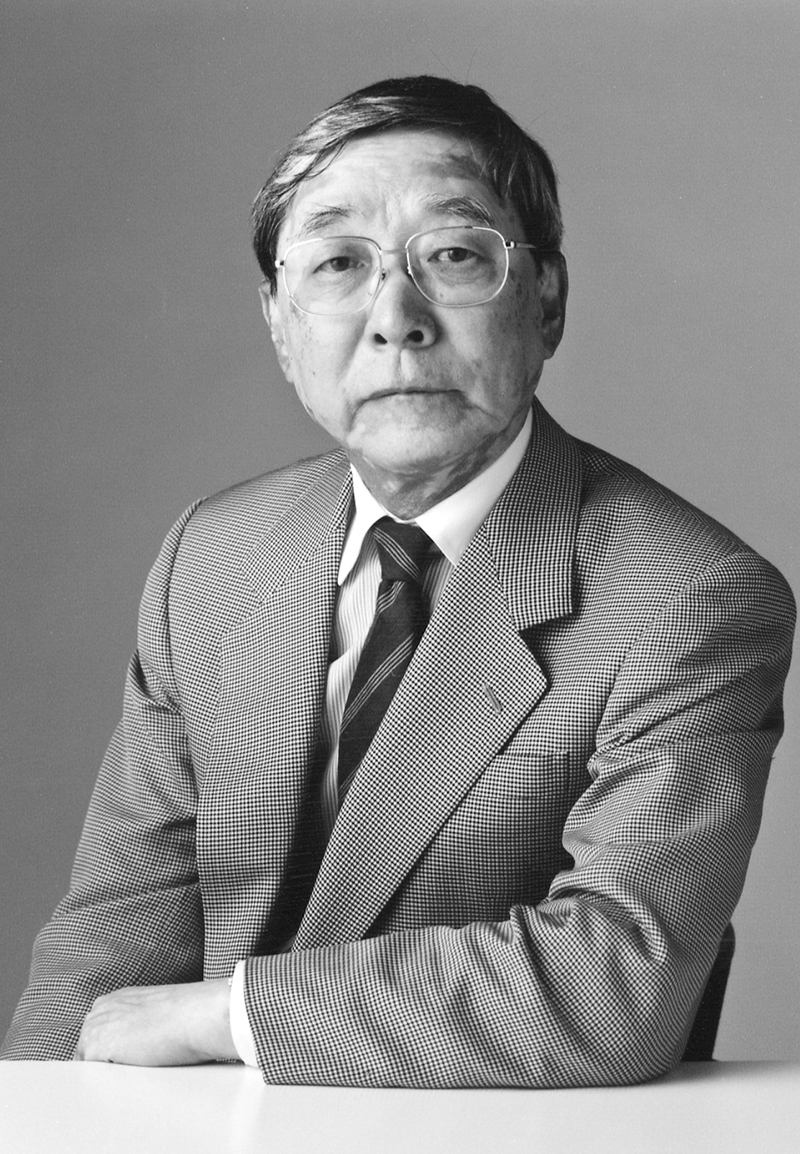
Description
Description
Born in the Taisho era, Ryuichi Yamashiro began his career before the war and was one of the most active figures in the early days of Japanese graphic design. He studied under graphic designer and painter Masaki Yamaguchi in his youth, and was also devoted to poetry and the works of Osamu Dazai, and at one time aspired to become a poet. He was introduced to design when he entered the design department of the Osaka City Crafts High School Design Department, and after graduation worked in commercial advertising at department stores such as Osaka Mitsukoshi, Hankyu and Takashimaya, etc. He was a member of the Japan Advertising Artists Club established in 1951, and in 1959 he participated in the establishment of the Nippon Design Center with Hiromu Hara and Yusaku Kamekura and worked for Toshiba, ASAHI BREWERIES, Asahi Kasei, Nomura Securities and TOYOTA MOTOR CORPORATION.
Yamashiro had previously worked in commercial and corporate advertising, but in 1969 he opened the door to a new world with a collage made from old postage stamps. At that time, "advertising expression was at a major turning point in the 1970s", writes copywriter Toshio Sawaguchi in his book about Yamashiro, “Neko ga ite shiawase” (MAGAZINE HOUSE, 1995). 'It was about to change from the previous appeal to commerciality to a kind of sympathetic advertising that appealed to the sensibilities of the times'. Among the events that symbolised that era were the 1970 slide of the University of Tokyo's Yasuda Auditorium, where the Zenkyoto (All-Campaign) had been holed up, and the subsequent calming down of the student movement, while the influence of the women's liberation movement called Women's Lib that took place in the US spread to Japan and heightened awareness of women's rights.
As if sensitive to these changing times, Yamashiro shifted the focus of his work from design to illustration. In 1972, he presented a painting of a white cat on the packaging of the French cigarette Goloise, which immediately became popular, especially among young women. In 1973, he left Nippon Design Centre and founded a design company called COMMUNICATION ARTS R with Shin Yoshida, Tsuguya Inoue and Kenji Oshita. From the 1980s onward created “Né Collage” works, collages of overseas stamps on cat illustrations, which later became his life's work.
Yamashiro's cat illustrations were not simply a matter of liking cats or a hobby, but a form of design expression, as he said at the time of his 1972 solo exhibition. "It was also well received by the so-called casual townspeople outside my circle of friends. (This seems to have brought about a change in my creative attitude. (omitted) By making cats my companions, I was able to deliver to women and children what I have always been thinking about, such as joy, tenderness, sadness, sorrow, fragility and anger, through pictures with cats". (“Neko no shouzou” KYURYUDO ART PUBLISHING, 1984).
Ikko Tanaka describes Yamashiro's designs, especially in the 50s and 60s, as follows. “He is a man who has opened a large window into the daily life expressions of advertising and the choice of words. (In the midst of the boiling pot of modern design ideas, he submitted brilliantly light ideas without losing human feelings anywhere. He is the man who liberated advertising copy, which had been crestfallen rhetoric, into an everyday perspective" ("Sekai no gurafiku dezain ggg Books No 30", DNP Art Communications, 1997).
The posters he produced by cutting and pasting photocopied letters from his masterpiece “Forest, Woods” and the cat illustrations he drew using acrylic and other paints convey the temperature of human hands and the message of human emotions. In his later years, he may have been pursuing a new form of design expression through cat illustrations rather than text or words.
A web museum called the "Ryuichi Yamashiro Web Museum", which compiles both Yamashiro's design and cat illustration work, was released in 2024. We spoke to Mr Mai Yoshida of COMMUNICATION ARTS R, who worked on its production, about the website, his relationship with Yamashiro and Yamashiro's archival material.
Masterpiece
Masterpiece
Newspaper advertisement “Totsuguhi chikaku...” Takashimaya (1954); ad “Kasimiron” Asahi Kasei (circa 1958), poster “Forest, Woods” (1955); poster “1955 sannin no kai” Hibiya Public Hall (1955); poster “Haiyuza / Kunisada Chuji” (1958), “World Exposition in Brussels” (1958), poster “Eikyu foto dessan” (1955); poster “Japan Association Against Cancer” (1959); poster “Italian fea” Takashimaya (1955); “Stuttgarto shitsunai Okesutora” Yomiuri Shimbun (1956); poster “Gensuibaku jikkenn sokuji teishi” (1957); newspaper Advertisement Newspaper advertisement “Birudukuri sandai” ASAHI BREWERIES (1960); Newspaper advertisement “Pasuturu hakase ni kanpai” ASAHI BREWERIES (1960); Newspaper advertisement, “obaachama, yunikaradesu”, Toshiba (1967); Poster “Anne no nikki” (1962); Magazine cover “Asahi Journal”, Asahi Shimbun Company (1959〜); “Tokyo Olympic geijutsu bumon”, Tokyo Olympics (1964); magazine cover, “Sendenkaigi” Sendenkaigi (1965); Poster “Collage '69 Exhibition” (1969); poster “Chijou ni aisuruhito ga nannin imasuka” Seibu Department Store (1969); Poster Kosaido Publishing (1969), Poster “Morisawa shashoku” Morisawa (1982); Poster “Né Collage Yamashiro Ryuichi exhibition” (1977); Poster “Neko no shouzou”, Seibu Department Store (1984); Solo exhibition work “Neko” (1988), etc.
Illustrations for the book
“Oka no ue no himawari”(illustrations for Taichi Yamada's serialised novel in the Asahi Shimbun newspaper, 1989); “Sashiesyu oka no ue nohimawari”(Chakra Books, 1989); “Neko ga ite shiawase” by Toshio Sawaguchi, MAGAZINE HOUSE (1995)
Books
“Neko no ehon Né Collage” Shinshokan (1978); “Neko no shouzou” KYURYUDO ART PUBLISHING (1984); “Konekonekoneko” MIKI SHOKO (1988); “Neko no dokuhaku” Hanashi no tokusyu, SHINCHOSHA (1992); “Neko no iru fukei” Komakusa Publishing (2019) , etc.
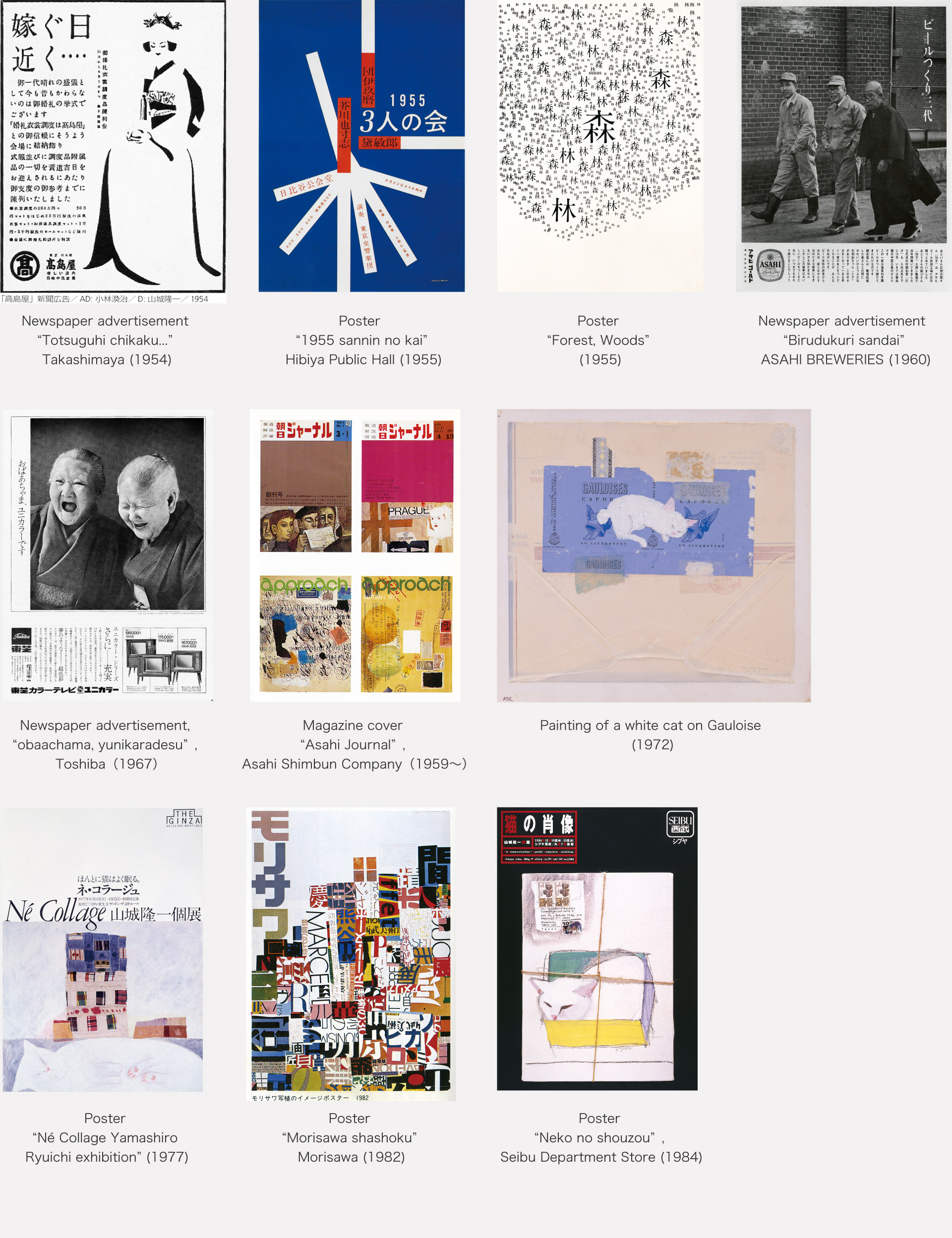
Interview
Interview
Ryuichi Yamashiro's web museum, accessible to everyone at any time
Background to website launch
ー I visited the website "Ryuichi Yamashiro Web Museum". It is very comprehensive. Can you tell us first about the relationship between you and Mr Yamashiro and why you created this work?
Yoshida One of the people who co-founded the company COMMUNICATION ARTS R (hereafter R) in 1973 after Mr Yamashiro left Nippon Design Center was my father, Shin Yoshida. Other co-founders were Tsuguya Inoue and Kenji Oshita. At the time, we had an office in Roppongi, with two staff and an accountant in addition to my father, and a desk for the external copywriters and writers we often asked to work for us.
After Mr Yamashiro's passing in 1997, my father took over as R's representative. The management of Mr Yamashiro's works and materials, as well as the use of his works and procedures for publication in exhibitions and catalogs, have been handled by R since before his death, and will continue to be managed by R. I joined R in 2011.
Then, in 2019, my father passed away suddenly, so my mother, who had been helping with the accounting, became the representative and I took over the work management-related matters. Later, in 2025, my mother passed away suddenly, so I am now running the business on my own.
ー Did your father ask you to take over Mr Yamashiro's materials before his passing?
Yoshida No, my father never said anything like that to me. But after he passed away, my father was always concerned about the works he left behind, and I saw him talking with my mother about how he had to do something to preserve them, as he had contributed to the design world. His work was fading rapidly, so my father had a rough memory of the kind of colours he used, so one time he selected dozens or so of his works, scanned them, colour-corrected them and made them into data.
Later, when my father passed away, I thought it would be a waste to leave them as they were and that it would be better to put them all together in something. So I thought about creating a website, and in my spare time from work, I gradually scanned the photos. I set a target of about 200 photos to be viewable when I first published the website. All the photos of the work were on positive film and remained filed like this.
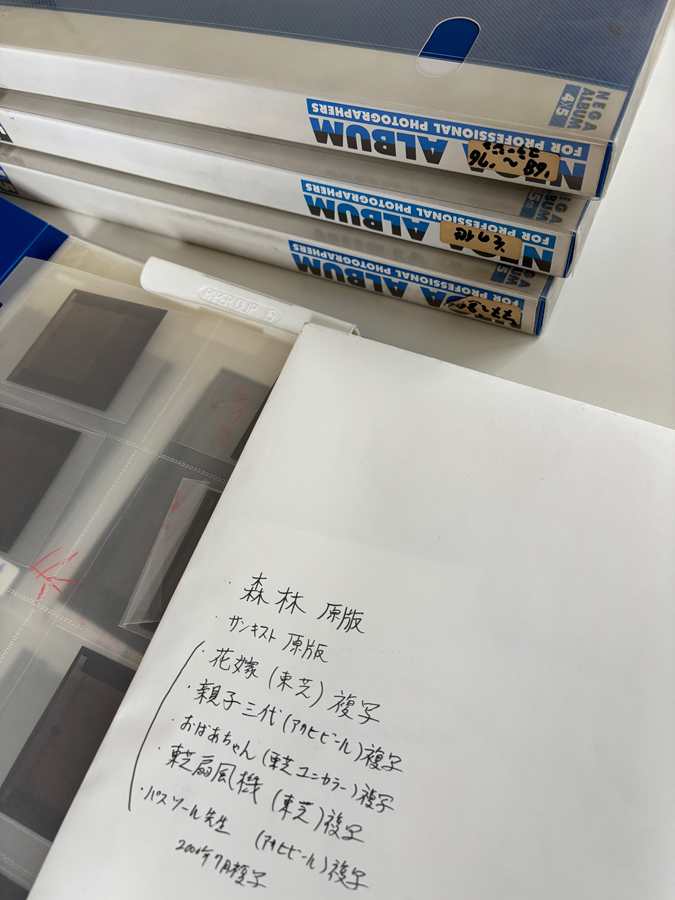
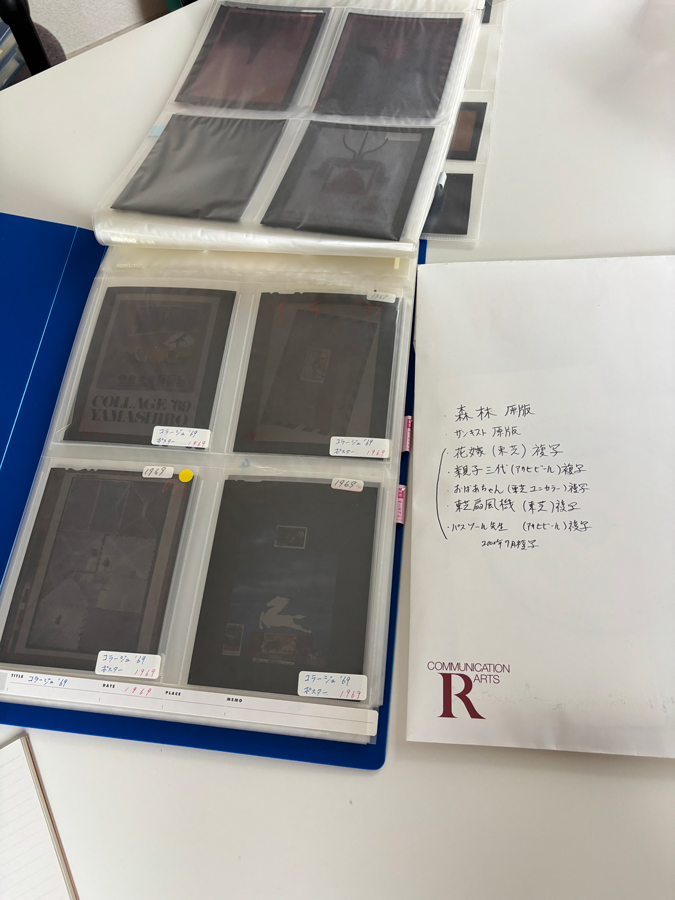
File containing photographs of Ryuichi Yamashiro's work.
ー I see that each photo is filed neatly and some are a respectable 4x5 size.
Yoshida In the Roppongi office there was a large shelf on which the posters were stored flat. I think it was before Dr Yamashiro passed away, when the office was being relocated, and his assistant asked the printer to copy those posters for us. There are not many posters. According to people around him, Mr Yamashiro was not too attached to keeping his work, saying that design is something to be consumed and not to be kept, and he disposed of most of it.
ー What made you decide to create a crowdfunded website?
Yoshida Initially, I was thinking of building a website at my own expense, but a design company I had been connected with since before I started working for them shared this office and advised me that if I was going to build a website, I should use crowdfunding. The person had a lot of experience with crowdfunding and recommended the platform READYFOR, which is strong in arts-related projects. I was completely new to this, so his assistant helped me with the production and taught me a lot as we went along. She also taught me how to add additional images, so my sister and I are now doing the updating work.
ー What did you offer to those who supported your crowdfunding?
Yoshida These include postcards, pouches, lithographs, newly produced T-shirts, eco-bags and books, which were held as stock items.
ー Are the plates included in the wedding favours for Mr and Mrs Yoshida? At the suggestion of the graphic designer Mr Keisuke Nagatomo, who was the host of the wedding party, Mr Yamashiro went to a potter's kiln in Okuizu and painted about 200 cat pictures on plates for everyone in attendance. In the book Portrait of a Cat (KYURYUDO, 1984), you write that Mr Nagatomo told you that you could make 200 plates in no time with your skills in three days, but the plates were rough and the brush did not glide, so you stayed at the kiln for several days and painted them in a desperate attempt to get them done.
Yoshida About four of the plates from that gift are still in our house. We didn't offer them through crowdfunding, but in 2024 we held a launch of the website "Ryuichi Yamashiro Web Museum" at Harakado in Harajuku, Tokyo, and exhibited them there. Mr Yamashiro also illustrated the menu for my parents' wedding reception with cats, two copies of which are still available. At the Harakado exhibition, we also displayed small-sized pamphlets, booklets and calendars other than posters, which have rarely been exhibited before. We wanted everyone to be able to see the illustrations and use of colours that do not look old even when seen today, so we exhibited only a small portion of them.
ー How did you announce the crowdfunding?
Yoshida I tried not to spend too much money, so it was SNS and "Neko Shimbun". Before his death, Mr Ryokuro Haraguchi, the editor-in-chief of Neko Shimbun, often used Mr Yamashiro's drawings on the cover of the magazine.
ー Did you decide on the structure of the website and the artworks you chose in consultation with the bereaved family? What kind of image of Mr Yamashiro did you initially want to portray on the website?
Yoshida His relatives are not in the design business, so I sent them a letter saying that I would create this kind of website, and the rest was done by the design agency I shared with.
When creating the website, I felt that I should not assume that this is the kind of person Yamashiro-sensei is, so I thought of a structure that allows people to see his work in as simple a way as possible. I think there are many fans of Mr Yamashiro's cat paintings, but I also want those fans to see his design work, so the top image is a mixture of cat paintings and design work. We would like to increase the number of design works in the future.
ー Will you be adding credits such as the year of production in the future? In the magazine "Design Note" (No.45, SEIBUNDO SHINKOSHA PUBLISHING, 2012), your father, Mr Shin Yoshida, was interviewed about Mr Yamashiro, and the year of production of his work is mentioned in the article.
Yoshida In the past, an accountant who had been with R's company for a long time compiled production years and other information, but he said that there were too few documents and many of them were not accurately dated. As for media coverage, my father would have basically checked and included the year of production, but the fact is that the notation differs from medium to medium. Also, the credit for work received by R is often put as COMMUNICATION ARTS R from a certain point in time. However, Mr Yamashiro said that it was acceptable to put the name of the person who worked on the project under the R credit.
ー "The Yearbook of Advertising Art" and "the ADC Yearbook", which can be viewed at the National Diet Library, list the year of production and the creator's credit, so that may also be helpful. I don't think all works are listed in those yearbooks, though.
Yoshida Actually, I think it would be better as an archive if it had proper credits such as the year of creation and the client, but I created the gallery on the website with the aim of making it easily accessible to anyone at any time. I would be happy if people are interested in looking at the various items and wondering what they are, or if they can be used as hints for ideas for people who create things. As the number of opportunities for Mr Yamashiro's work to be shown in the public eye is decreasing year by year, I would like to continue uploading and updating her work.
Ryuichi Yamashiro and Shin Yoshida, Company R
ー Did you meet your father, Mr Shin Yoshida,, and Mr Yamashiro at the Nippon Design Center?
Yoshida Yes, since he joined the company, his father has always been close to Mr Yamashiro. My father was the first to retire. It seems that when my father was travelling around the world, he was contacted by Mr Yamashiro and told to come back because he was going to create a company, which led to the establishment of the COMMUNICATION ARTS R company in 1973.
Mr Yusaku Kamekura, Mr Ikko Tanaka and Mr Kazumasa Nagai, who were involved in the establishment of Nippon Design Center, are all considered to be graphic artists, but Mr Yamashiro was in a slightly different position to the others. It is said that Mr Yamashiro was the only one who could do commercial design. This is because Mr Yamashiro had experience in many commercial advertisements before and after the war at companies such as Mitsukoshi Osaka, Hankyu Department Store, Osaka Takashimaya, Hankyu Corporation and Takashimaya Tokyo.
ー Many designers of Mr Yamashiro's generation named their firms after themselves, such as Yamashiro Design Office, but it was called COMMUNICATION ARTS R, wasn't it? It is also interesting to note that people from various professions, such as copywriters, belonged to the firm. I imagine that you must have had a new sensibility and a progressive spirit.
Yoshida The name of the office was thought up by Mr Yamashiro, and he once asked his father what the "R" meant, but Mr Yamashiro did not tell him. He said that it wasn't an R for Ryuichi either, and that it "contains many meanings"; in the end, only Mr Yamashiro knows what the R means.
ー Mr Yamashiro worked more as an art director than as a designer, so perhaps it was because he felt that he was working as a team rather than as his own office. Your relationship with your father must have been more like that of a partner than that of a pupil of Mr Yamashiro's.
Yoshida Mr Yamashiro was not a very negative person, so my father was allowed to do things freely and was very fond of him. I heard that the name "Oshin" is actually a pseudonym, and that Mr Yamashiro gave it to him. My father never told me why. My father gave Mr Yamashiro a Shih Tzu dog as a thank-you for being his matchmaker, and Mr Yamashiro's wife named him "Shin Shin" because he was a dog that he got from my father (Yoshida Shin).
Representative poster "Forest, Woods"
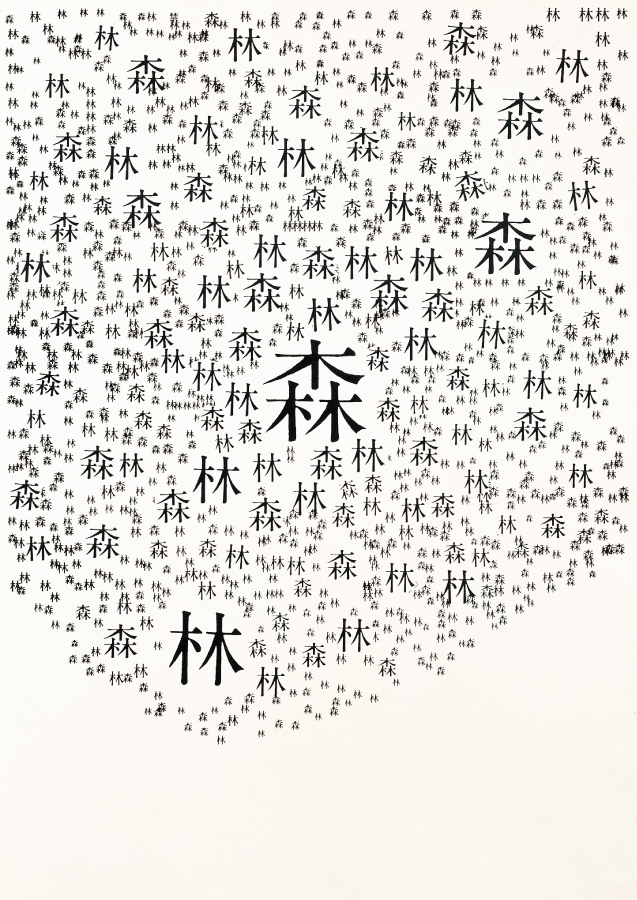
Poster "Forest, Woods" (1955)
ー I would like to ask you about some of Mr Yamashiro's best-known works. Do you know what the most famous ‘"Forest, Woods" piece was created for?
Yoshida As I read in an interview somewhere, it seems to have been created as an experimental approach to see how far one could go with the use of transcription. This work, a transcription poster composed entirely of text, is included in art textbooks for junior high school students every year as part of the history of design and art. We handle the permission procedures for its publication here every time.
ー Did you cut and paste these forest and tree letter transcriptions yourself?
Yoshida No, it seems that he gave a rough image to the transcription operator at the printing house and had it made. I heard that they were testing how much they could create without moving their own hands. I suspect that the instructions for adding and subtracting were repeated many times, adding letters to the ones that came up and overlaying them on top. I don't think they could have done it just by giving instructions once, because there are many overlapping letters and only a few overlapping letters in some places. If you look closely, you can see that some of the overlapping letters are blurred or missing. It is not well known, but there is only one character in here that is "forbidden". I asked a lot of people why, but they said they didn't know. But it's nice to have this kind of playfulness.
ー There is indeed only one character for "forbidden". It is still impressive that a single worldview is created with just the characters for forest and woodland. I understand that Mr Yamashiro was fond of literature and poetry, so perhaps he has a connection to such literary worlds.
Yoshida Perhaps there is a story in him. I have read in an interview that, with regard to letterforms, "the wind has to flow between the letters". I heard that you liked writing poetry, but you never actually made a book of poetry. There are only a few illustrations of cats with a bit of writing added.
ー I understand that this "Forest, Woods" poster is in the collection of the Museum of Modern Art (MoMA) in New York.
Yoshida Yes, and several other European museums have collections of his work. Recently, there has been a renewed interest in Japanese design abroad, and we are sometimes contacted by people who say, "We are holding an exhibition looking back at Japanese design, and we would like to use his work in the collection". In other cases, they do not have our contact details and contact the DNP Cultural Promotion Foundation, which sometimes forwards their emails to us. All of them wish to use the "Forest, Woods" poster. Also, in Japan, the National Museum of Art, Osaka has many works in its collection, which I believe were donated by Mr Yamashiro's wife.
Unique colours of Ryuichi Yamashiro design
ー Have you ever been cared for or taught design by Mr Yamashiro when you were a child?
Yoshida He looked after me, but he never taught me how to design. My parents used to take me to their office from when I was very young, and I have memories of Mr Yamashiro putting everything I liked or touched in my basket at KIDDY LAND in Harajuku at Christmas time. When I started visiting his office and home, it was around the time when he started painting cats on canvas, so in my mind he was an illustrator, not a designer.
ー Did you get into graphics by watching your father's work?
Yoshida No, I hardly ever saw my father work and I never saw him in a suit, so I didn't know what he did until I was about primary school age. My mother was also originally a graphic designer and worked for another company. The adults who gathered at our house were photographers, copywriters and designers, so I couldn't imagine a job other than making things. I entered university at Tama Art University in the graphics department.
ー Was it a natural progression for you to take over the R company?
Yoshida After graduating from university, I looked for a job, but my father thought I would join the R company after graduating from university, so I started working there part-time just as one of the staff was going independent. That was in 2011.
ー What do you think of Yamashiro's designs? There are illustrations, designs and artworks.
Yoshida It wasn't until I was a university student that I properly saw Yamashiro Design's work. At that time, graphic design was dominated by strong designs with stimulating colours. Unlike those designs, Mr Yamashiro's work, both in terms of graphics and cat illustrations, had a gentle atmosphere and a unique view of the world, and I was particularly attracted to the use of colour. His use of colour varies according to age, but the overall image is of a slightly duller, deeper colour.
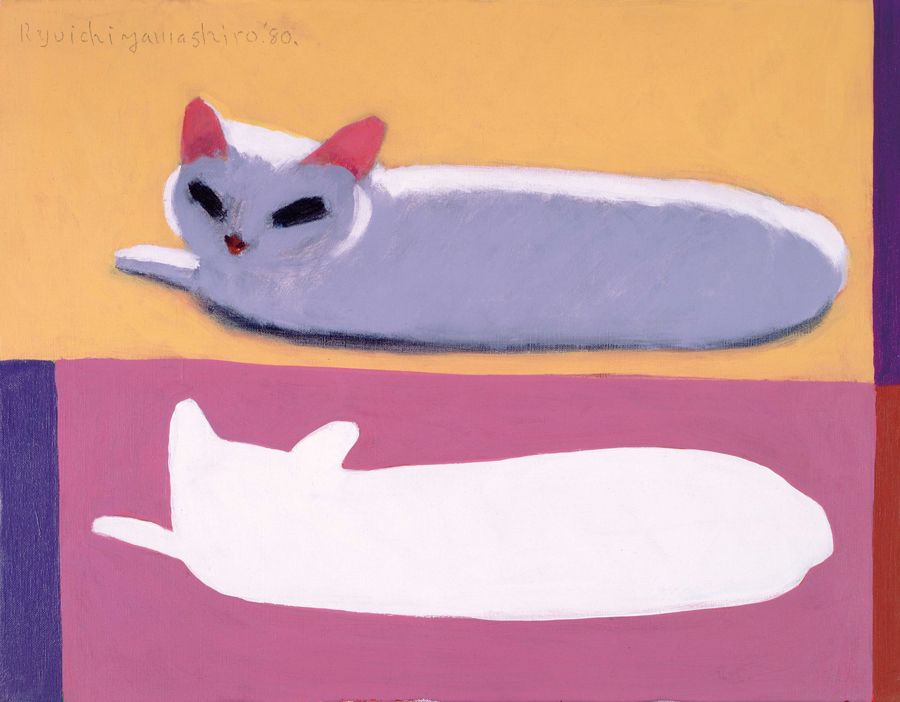
Illustration of a cat by Ryuichi Yamashiro.
ー The material used for this cat illustration is probably oil paint. The color scheme is unique, but it looks like a DIC Graphics color sample “Traditional French Colors”.
Yoshida Mr Yamashiro used both oil and acrylic paints. He had a lot of acrylic paint left over, so he probably painted more with acrylics in his later years. This is a file of calendars that Mr Yamashiro worked on, which is both illustrative and design-like, and I think his use of colour with such subtle nuances is unique. The colour swatches often used in R's company were DIC's "Traditional French Colours" and "Traditional Chinese Colours", so Mr Yamashiro's colour specifications are similar to these.
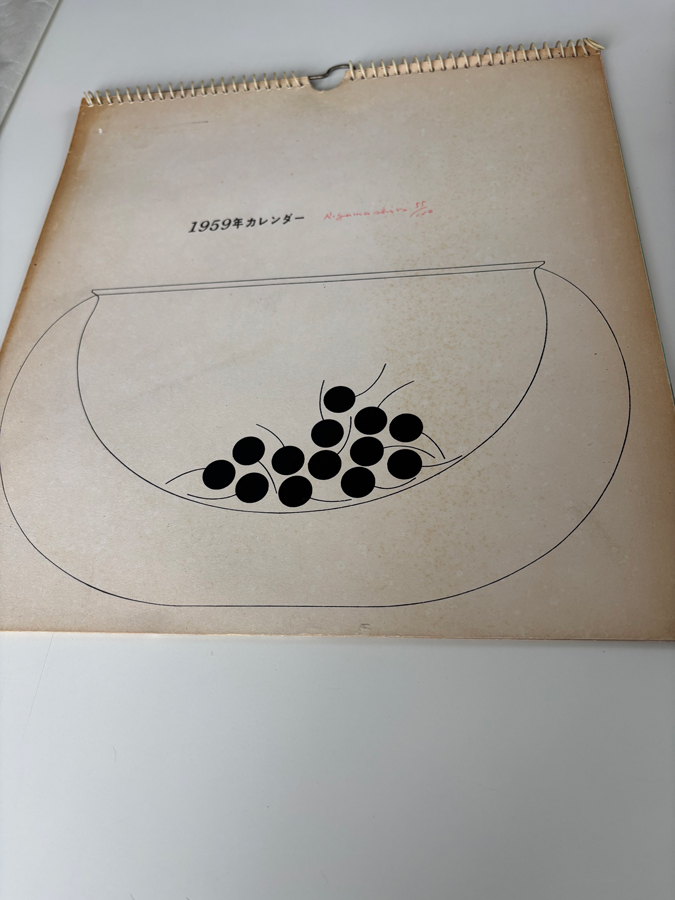
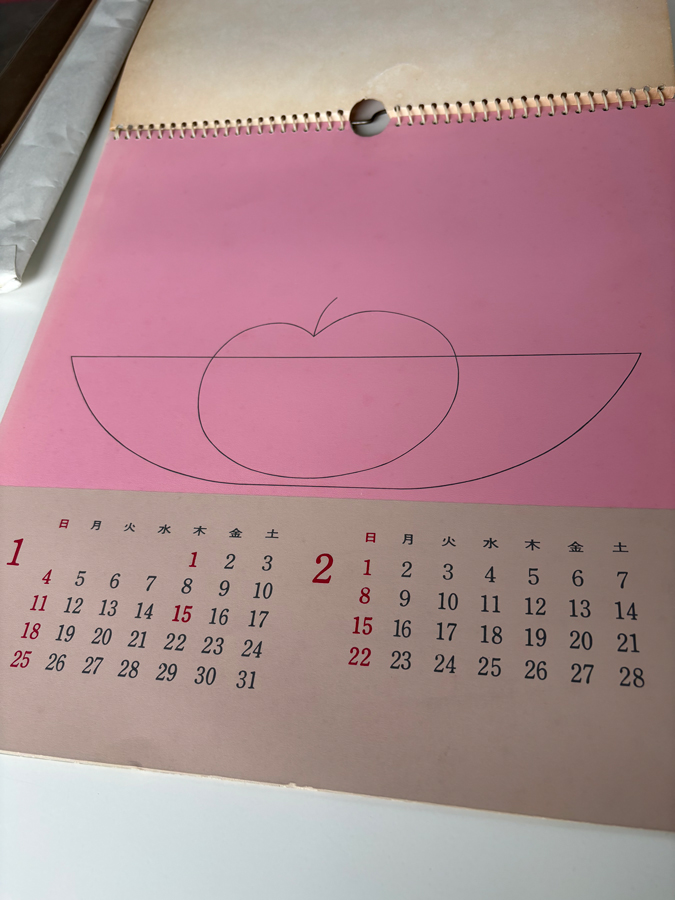
1959 calendar designed by Ryuichi Yamashiro.
ー This is a calendar from 1959, when Mr Yamashiro was freelance before he participated in the launch of the Nippon Design Center.
Yoshida There used to be a culture of handing out calendars like this, which is probably why there were so many of Yamashiro-sensei's calendars. 1959 calendar may have been given out to various people when he was freelance. 55 is written on it, so I think it is number 55 out of 100 copies made. The calendar was printed by Kosaido Publishing, and every year R's company asked Kosaido Publishing to produce a calendar in a unique B1 format, split vertically into three sections. Mr Yamashiro originally produced Kosaido Publishing's calendars in this format.
Contents of archival material held by R
ー What archival material do you have on Mr Yamashiro?
Yoshida There are more detailed productions such as these calendars, concert and theatre brochures and catalogues than posters, and posters are stored on shelves in the office that can be laid flat. I don't feel that I have always stored them particularly strictly, and they are still in that state. I am in the process of compiling the image data of the works on the occasion of the production of the website "Ryuichi Yamashiro Web Museum".
The picture on display there is Yamashiro-sensei drawn by Mr Makoto Wada. When my father and I were sorting through the materials for the "Ne, Ko" exhibition held at the Seibu Shibuya shop in 2017, which displayed Mr Yamashiro's cat works, we also found a letter with a wedding report of Mr Wada's marriage. There are also works and materials by other designers in our archives. There are also unpublished works by Mr Kazumasa Nagai. My father told me that during his time at the Nippon Design Center, various designers came to him with prototypes for consultation, and the prototypes from that time are still in this office. Mr Nagai's work is a large silkscreen work of about 2 metres in fluorescent ink. It cannot be said with certainty that it belongs to Mr Nagai, as there is no signature on it, but I am wondering what to do with such works in the future.
ー In our interviews for this design archive, we have heard that there are many designers who own other people's work. I'd like to ask you, as a designer who has created a museum on the web, what are your thoughts on the lack of design museums in Japan that store archived design materials?
Yoshida Personally, I think it is good to have a place where you can see actual objects from different periods. If there are damaged parts, you can see how much time has passed, and you can feel the temperature. I would like there to be a design museum in Japan, but I think it requires a lot of money and effort to make it happen, so I think it is difficult to find people who are willing to lend their support and sponsorship to such a project in this day and age.
ー Today, when I saw the actual poster of "Forest, Woods", I was reminded that the fascination of the overlapping letters and the subtle nuances of the calendar's colours can only be appreciated in full size. Also, this website was created by someone who is not a family member or apprentice, which I think is really wonderful because it is not easy to do. Please keep up the good work.
Yoshida There is not much I can do, but I will do what I can.
ー Thank you very much for your valuable talk today.
Enquiry:
COMMUNICATION ARTS R
https://ryuichiyamashiro.com

